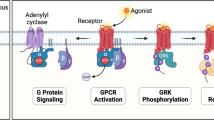Abstract
The pseudorabies virus glycoprotein III (PrV-gIII) has been identified previously as the major viral component binding to a heparin-like receptor on the surface of target cells. The amino acid sequence of gIII contains three regions corresponding to consensus sequences for heparin binding. A synthetic peptide corresponding to amino acids 134 to 141 of PrV-gIII bound heparin in a dot blot assay. In contrast, a synthetic peptide derived from amino acids 290–299 of PrV-gIII did not bind heparin. We therefore conclude that the region containing amino acid 134–141 is involved in binding to the heparin-like cellular receptor.
Similar content being viewed by others
References
Baird A, Schubert D, Ling N, Guillemin R (1988) Receptor- and heparin-binding domains of basic fibroblast growth factor. Proc Natl Acad Sci USA 85:2324–2328
Ben-Porat T, Kaplan AS (1985) Molecular biology of pseudorabies virus. In: Roizman B (ed) The herpesviruses, vol 3. Plenum Publishing, New York, pp 105–173
Cardin AD, Weintraub HJR (1989) Molecular modeling of protein-glycosaminoglycan interactions. Arteriosclerosis 9:21–32
Devereux J, Haeberli P, Smithies O (1984) A comprehensive set of sequence analysis programs for the VAX. Nucleic Acids Res 12:387–395
Evans DLI, Marshall CJ, Christey PB, Carrell RB (1992) Heparin-binding site, conformational change, and activation of antithrombin. Biochemistry 31:12629–12642
Ferran DS, Sobel M, Harris RB (1992) Design and synthesis of a helix heparin-binding peptide. Biochemistry 31:5010–5016
Guo N-H, Krutsch HC, Nègre E, Vogel T, Blake DA, Roberts DD (1992) Heparin- and sulfatide-binding peptides from the type I repeats of human thrombospondin promote melanoma cell adhesion. Proc Natl Acad Sci USA 89:3040–3044
Herold BC, WuDunn D, Soltys N, Spear PG (1991) Glycoprotein C of herpes simplex virus type 1 plays a principal role in the adsorption of virus to cells and in infectivity. J Virol 65:1090–1098
Hirose N, Krivanek M, Jackson RL, Cardin AD (1986) A dot-blot assay for heparin-binding proteins. Anal Biochem 156:320–325
Kaiser E, Colescott RL, Bossinger CD, Cook PI (1970) Color test for detection of free terminal amino groups in the solid-phase synthesis of peptides. Anal Biochem 34:595–598
Kost C, Stüber W, Ehrlich HJ, Pannekoek H, Preissner KT (1992) Mapping of binding sites for heparin, plasminogen activator inhibitor-1, and plasminogen to vitronectin's heparinbinding region reveals a novel vitronectin-dependent feedback mechanism for the control of plasmin formation. J Biol Chem 267:12098–12105
Lellouch AC, Lansbury PT Jr (1992) A peptide model for the heparin binding site of antithrombin III. Biochemistry 31:2279–2285
Liang X, Babiuk LA, Zamb TJ (1991) Pseudorabies virus gIII and bovine herpesvirus 1 gIII share complementary functions. J Virol 65:5553–5557
Mettenleiter TC, Zsak L, Zuckermann F, Sugg N, Kern H, Ben-Porat T (1990) Interaction of glycoprotein gIII with a cellular heparin-like substance mediates adsorption of Pseudorabies virus. J Virol 64:278–285
Pratt CW, Whinna HC, Church FC (1992) A comparison of three heparin-binding serine proteinase inhibitors. J Biol Chem 267:8795–8801
Robbins AK, Watson RJ, Whealy ME, Hays WW, Enquist LW (1986) Characterization of a pseudorabies virus glycoprotein gene with homology to herpes simplex virus type 1 and type 2 glycoprotein C. J Virol 58:339–347
Robbins AK, Dorney DJ, Wathen MW, Whealy ME, Gold C, Watson RJ, Holland LE, Weed SD, Levine M, Glorioso JC, Enquist LW (1987) The pseudorabies virus gII gene is closely related to the gB glycoprotein gene of herpes simplex virus. J Virol 61:2691–2701
Rziha HJ, Mettenleiter TC, Ohlinger V, Wittmann G (1986) Herpesvirus (pseudorabies virus) latency in swine: ocurrence and physical state of viral DNA in neural tissues. Virology 155:600–613
Sawitzky D, Hampl H, Habermehl K-O (1990) Comparison of heparin-sensitive attachment of pseudorabies virus and herpes simples virus type 1 and identification of heparin-binding PrV-glycoproteins. J Gen Virol 71:1221–1225
Sobel M, Soler DF, Kermode JC, Harris RB (1992) Localization and characterization of a heparin-binding domain peptide of human von Willebrand factor. J Biol Chem 267:8857–8862
Wolfe HR, Wilk RR (1989) The RaMPS system: symplified peptide synthesis for life science researchers. Peptide Res 2:352–356
WuDunn D, Spear PG (1989) Initial interaction of herpes simplex virus with cells is binding to heparan sulfate. J Virol 63:52–58
Zuckermann F, Zsak L, Reilly L, Sugg N, Ben-Porat T (1989) Early interactions of pseudorabies virus with host cells: function of glycoprotein gIII. J Virol 63:3323–3329
Author information
Authors and Affiliations
Rights and permissions
About this article
Cite this article
Sawitzky, D., Voigt, A. & Habermehl, KO. A peptide-model for the heparin-binding property of pseudorabies virus glycoprotein III. Med Microbiol Immunol 182, 285–292 (1993). https://doi.org/10.1007/BF00191944
Received:
Issue Date:
DOI: https://doi.org/10.1007/BF00191944




